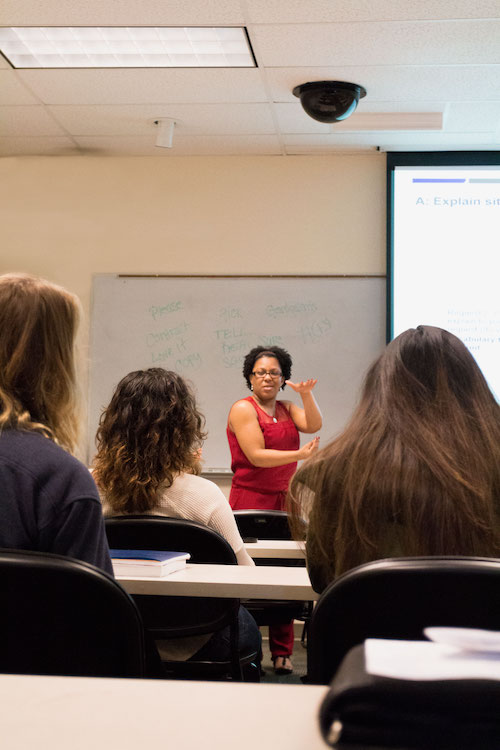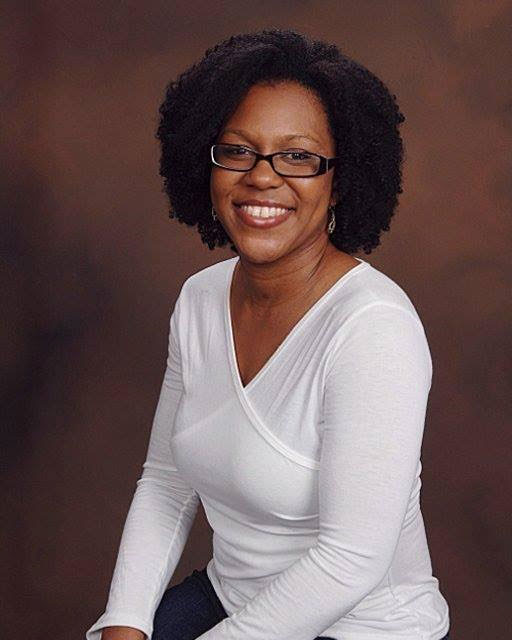CSUMB Magazine
Many Ways To Speak Your Truth

Your body can speak. Your body can listen. Your mind adapts and strong connections are made.
Silent classroom
Creating these connections is a passion for American Sign Language (ASL) Instructor Regina Daniels. Students in her class learn to communicate powerfully without speaking a word. They don’t have a choice. Nearly every one of her students can hear. Daniels herself is deaf.
Another typical day in class has begun as Daniels stands in front of her students, signing quickly and with extensive eye contact as she tells students about the day’s exercise. The students sign back. If they have a question, they raise their hand and Daniels points to them, nods and smiles. The student with the question signs at Daniels. She signs back. Not a word is spoken. The room is quiet.
A whiteboard and projection screen behind Daniels show words and visuals to accompany the lesson. She indicates for the students to work with each other. The students turn to the person next to them and sign each other for several minutes. Again, silence. When Daniels wants their attention again, she taps the whiteboard with her fist. The signing stops and all eyes are directed forward.
Students are forced to think outside of the box and learn quickly to “turn their voices off” according to Daniels. On the first day of class, Daniels communicates through an interpreter. After that, it’s only her. Communication is through a whiteboard and PowerPoint before students become proficient enough in ASL.
The in-class tests include students working together for approximately 20 minutes to practice 10 to 15 words in spelling, 10 to 15 words in vocabulary and then identify sentence structures. Afterwards, Daniels asks students one question at a time through signing. The students write their answers down on paper before Daniels moves onto the next question. This process takes nearly an hour. In addition, each student creates a two-minute video of themselves telling a story through signing, which they are graded on.

Positive identity
“The structure of ASL is completely different than any other language – you use your hands and body to not only convey the words, but the inflection and tone,” Daniels said. “I enjoy exposing them to Deaf culture and what it means to be deaf.”
Deaf culture, spelled with a capital D and called “big D Deaf” in speech and ASL, refers to a set of shared values in the deaf community, according to Daniels. They view being deaf as a difference and a source of positive identity, not a disability or disease.
Daniels knows Deaf culture well. Born and raised in New Orleans, Daniels’ mother and sister were deaf. She learned ASL before English. Family conversations tended to happen in the kitchen where the lighting was good for signing. Everything in life revolved around what was in front of them, according to Daniels. Face to face, expressive conversations and noises for emotional emphasis. Dinner conversations could be very animated.
Her parents emphasized interaction with everyone, not just people who identified with Deaf culture. She attended a regular public school as a child. High school was a boarding school specifically for the deaf. Other career pursuits then followed, including dancing and acting with minor roles in several television shows and films. Then Daniels discovered teaching thanks to the encouragement of one of her college professors.
Another world
A recent transplant to California, Daniels came to CSUMB three years ago after spending time in Chicago and the East Coast. Along with ASL, Daniels hopes to teach dance someday. A fan of hip-hop and modern dance music, Daniels went off the beat and vibration when she danced professionally. “I have to feel the song,” she said.
Another day of class wraps up for Daniels and her students. It’s nearly two hours where the spoken word is not needed. The students quietly put their books in bags and begin to walk out. Many are still signing each other with smiles.
“I love it when I see students have that ‘light bulb’ moment,” Daniels said. “It can open up another world, helping them communicate in ways they never thought possible.”